Thanks Alex, I saw that part # but the eentsy picture in the library window doesn’t help much. As you say, as long as it’s close then good enough for now. I really have no idea what the best way to proceed is just figured on throwing ricks until something breaks. Hopefully several approaches can lead to one good one.
Wight, really happy to have you back in.
.
This picture is closest to a ‘stripped’ version of the FT driver I have at hand. It’s the exact driver I did modify, pic taken while in the process of swapping MCUs. What you can’t see is the connection between pin4 and pin6 under the PAM2803.
.
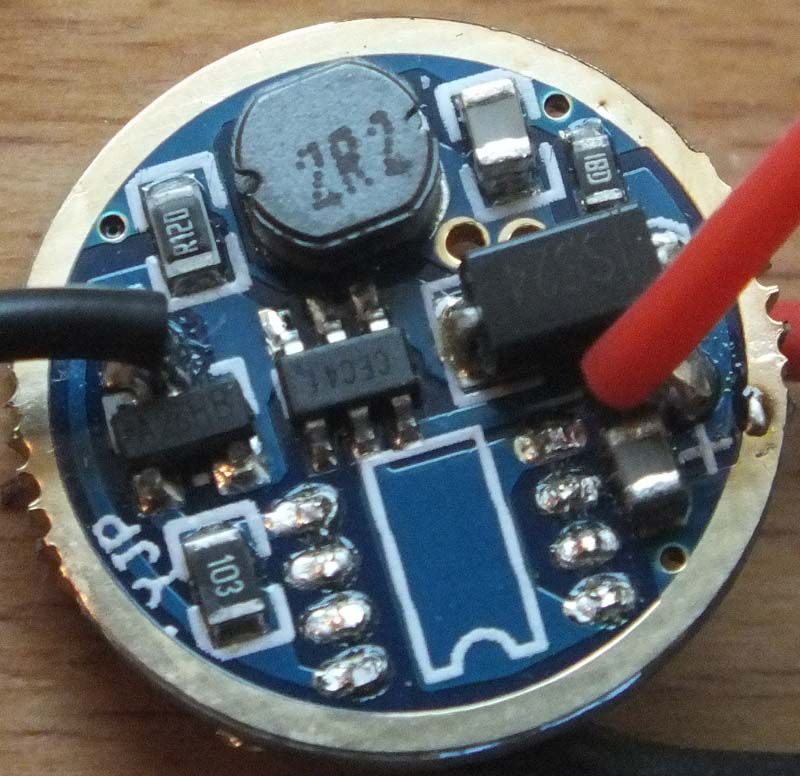
.
There is the other thread where we discussed the boost driver and @ImA4Wheelr had drawn a schematic of the FT driver. Just borrowing, hope that’s ok.
My successful Mod was this:
[EDIT: new picture, first picture was missing the connection between MCUpin6 and FetGate (the PWM signal).
.
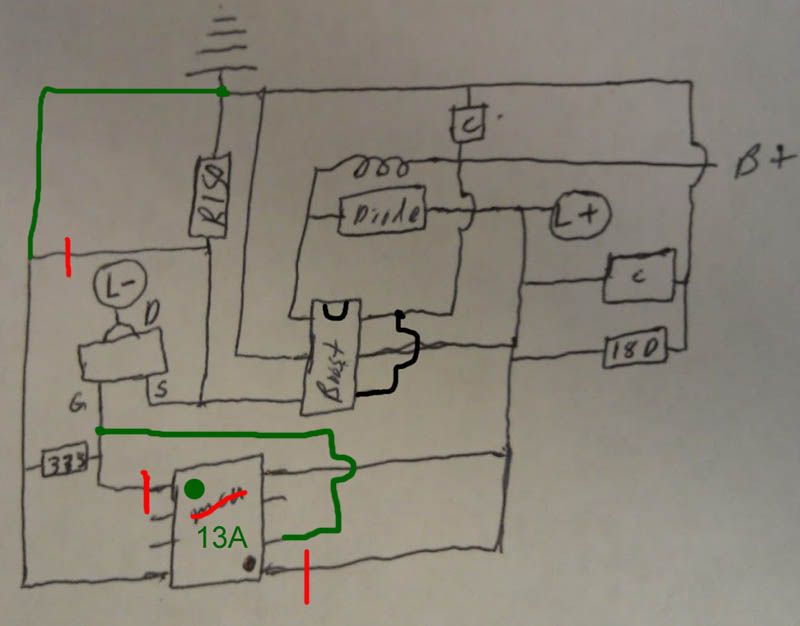
.
Thanks for stepping in ![]()
The BAT60A is quite easy to source in Europe but plays hard to get overseas.
I had briefly tested the BAT60A on my modded FT driver as well and it worked.
.
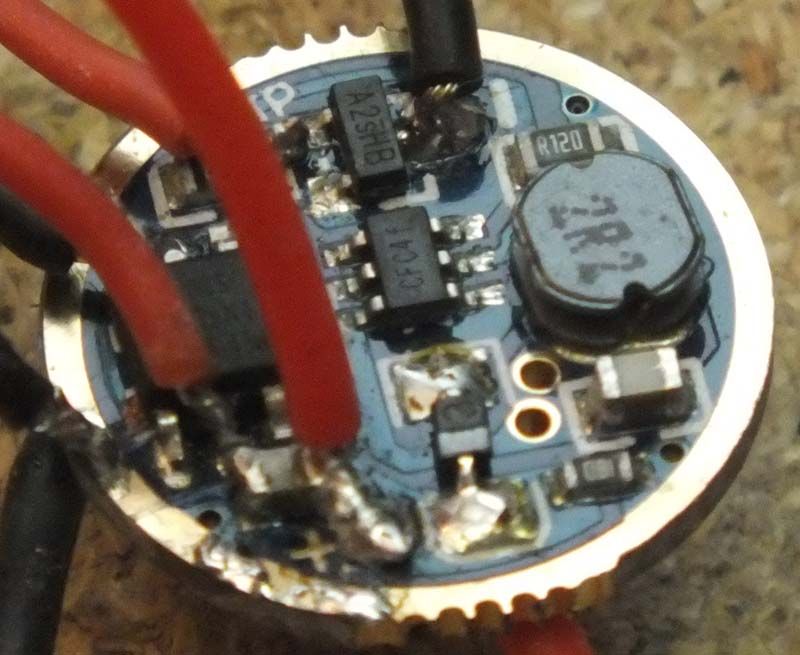
This is the layout I used for the board, presumably following the circuit of the modded FT driver.
Including R2 and R3 (well, it had worked with them…).
C2 and C3 are in parallel, C2 as close to PAMpin5 as possible and C3 as close to MCUpin8 as possible
R and C (0805 or 0603) are almost all reduced in size.
L is 42mm and the part selfmade (part is only tDocu, pads are simple layer 1 current paths). Eagle inductors are scarce.
Overall size is 15.4mm to ensure a GND ring of about 15mm.
Well, FYI:
.
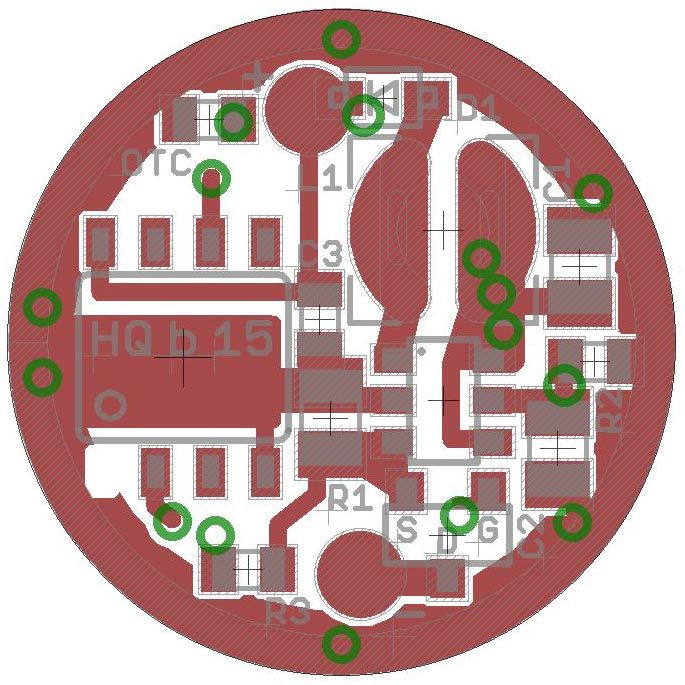
.
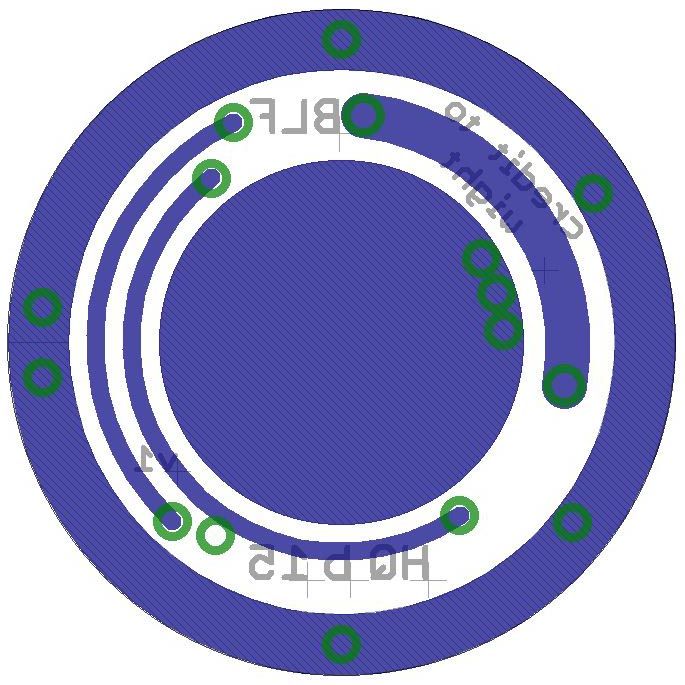
HarleyQuin, that’s a pretty clear pic. Looks like they’ve bumped down from R150 to R120 for a small increase in output? Probably just whatever was cheapest at the time but R12 is the right component since FT lists it as an 800mA driver.
HarleyQuin and I recently talked about what the two “extra” resistors are doing in there. I noted that they were not part of the application circuit and HQ pointed out that they are present on the working design sold by FT. The resistors in question are the two 0603 seen in post #57. According to HarleyQuin’s circuit the 33k one connects gate to GND (through Rsense) and the 150k one connects Vout/Vcc to GND directly. The 33k one seems to be a pulldown resistor for the transistor, but the 150k one… no idea really.
The following is probably another case of “whatever is cheapest” but I noticed that on one of the no-MCU versions FT sells there is clearly an R150 for sense and an R150 connecting LED- across where the missing transistor is. It’s hard to see on the other no-MCU listing, but I think that one shows a zero-ohm jumper. Again, I seriously doubt that any of that is relevant.
FWIW what both no-MCU examples do show is that these two resistors are not populated (333/33k and 18D/150k) when the MCU/transistor is not populated! Maybe the 150k is a bleeder to help ensure clean mode changes? This is something that RMM just pointed out in another thread when the topic of using an LDO in a clicky came up. I feel decently confident on that now, that’s probably what we are looking at.
Come to think of it, does HQ’s recent pic showing the FT board with MCU removed show that the MCU ground is on the sense side of Rsense? (eg both the pulldown and MCU GND are not connected directly to GND?) Is there any significance to that?
This might be due to differences in the MCUs (Attiny vs PIC?)
When I first swapped MCUs I connected pin4 of the Attiny13a as it was with the original MCU, not directly to GND but to the other side of Rsense. That did not work. Modes would not change (I briefly wrote it in Post#57). So I furthermore cut the trace to MCUpin4 on the board and connected MCUpin4 to GND and the driver worked.
Thanks HQ, that gives me a bit more confidence to proceed. I doubt I’ll be as creative as you but it will at the very least waste a few days.
Ah, thanks HQ. I feel really off balance after my time off from the forum. ![]() You did specifically talk about that in post #57, I just didn’t absorb it when I looked at your post. I’m not 100% sure what’s up with the weird GND path for the existing MCU on the FT driver. IIRC we may have seen something similar in ImA4Wheelr’s HX-1175b1 thread? I dunno and I’m not going to try and hunt it down right now. I do strongly suspect that I’ve seen similar wiring on another Chinese driver. For me it’s good enough that you noticed the same thing, tried it with the ATtiny, and ended up changing it to a direct GND.
You did specifically talk about that in post #57, I just didn’t absorb it when I looked at your post. I’m not 100% sure what’s up with the weird GND path for the existing MCU on the FT driver. IIRC we may have seen something similar in ImA4Wheelr’s HX-1175b1 thread? I dunno and I’m not going to try and hunt it down right now. I do strongly suspect that I’ve seen similar wiring on another Chinese driver. For me it’s good enough that you noticed the same thing, tried it with the ATtiny, and ended up changing it to a direct GND.
On a side note HQ, do you really work with your Eagle set to a white background or do you just do that for screenshots? I just tried it and ouch it didn’t feel good - especially with both the bottom and top stuff enabled at the same time, where I spend a fair amount of time. Maybe I’d get used to it. ![]()
![]() For anyone who doesn’t use Eagle: the default is black like in the screenshots I sometimes post.
For anyone who doesn’t use Eagle: the default is black like in the screenshots I sometimes post.
I don’t yet understand how the lack of the pulldown/bleed resistors would burn a PAM2803. Hopefully when the parts to build this thing show up I’ll be really motivated and setup the scope. (I laid out a lot of cash for that thing, we should get some use out of it…) With the scope on 1xAA we can observe the behavior without the pulldown/bleeder. Then install them (stack the bleeder on the output cap and airwire the pulldown) and check everything with the scope again. With any luck this will demonstrate any spikes they may help minimize without burning the PAM2803.
I don’t have much to contribute here, other than to say I also use a white background and it definitely was the default when I installed Eagle.
In the board editor? Crazy! Since my memory is on the foggy side I had to do a sanity check - sure enough, in the past black was the default. A quick Google Images search for eagle+board+editor corroborates this. I wonder why they changed it?
I should point out that all I posted are more or less singular events. It was one PAM2803 that released smoke, one successful rebuilt FastTech driver, one built HQb15v1 that did not work as expected (3 modes, mode change works, but flickering in all modes). I can’t explain what happened or went wrong. It’s not that I was setting up test series here…
.
The PAM2803 that died was on a Nanjg110. I had only 2 more at hand at the time and did not want to lose them. Then the FT board arrived and I went with them - including the reistors.
.
The resistors (that I dubbed R2 and R3) are, as @wight pointed out, only present on the boards with MCU. They were not needed when I tested the BAT60A on a single mode Nanjg110 (post#35). But I don’t know what these resistors are there for on the FastTech driver.
R2 (“18D” = 150kOhm) is between LED+ and GND.
R3 (“103” = 10kOhm) is between FetSource/PAMpin3/Rsense and FetGate/PWMsignal.
.
The HQb15v1 I did model after the successful FT conversion. Can’t say whether I misdesigned it, a part is defect or I did a bad (rework-station-) solder job. Next weekend might show, hopefully.
.
I started using Eagle in summer ’14, installed it on 2 PCs and have never seen anything but a white background. Needless to say, I’m simply used to it.
.
I’m aiming for 1AA and 2AA operation, 2AA for several Mini Maglites which can so nicely be converted to a triple using a modded P60 pill. Very family friendly for those I don’t want to burden with lithium-ion cells.
In the past editions it was black and I always switched to white so I could see where the cursor was. Images seem more striking on a black background so I switch to that for screen shots.
Heh, maybe the “more striking” bit is a concentration aid for me. ![]() I use the default cursor which is “inverted” from whatever it’s hovering over (black = white, red = blue, green = pink, etc). Since I was curios I checked it out on both backgrounds just now. I actually find the cursor easier to see on the black background. Did you check out the “Large” cursor while you were in there?
I use the default cursor which is “inverted” from whatever it’s hovering over (black = white, red = blue, green = pink, etc). Since I was curios I checked it out on both backgrounds just now. I actually find the cursor easier to see on the black background. Did you check out the “Large” cursor while you were in there?
No, just the background color. I’ll have a look next time I’m in there.
Liftoff, we have a liftoff…
15mm boost driver (v1) working
.
Partlist and used Firmware below
Rebuilt on a 2nd board, running fine.
2x 2AA and 3x 1AA (Eneloops) drained so far, about 200 mode changes, all good.
It’s a HQb15 de-luxe with Coilcraft inductor and high value capacitors.
Board is the same layout as in post#72 above.
.
Oshpark link for HQb15 v1 EDIT: Obsolete as HQB15 v2 is finished, see post#96


.
Driver height with this inductor is 3.7mm (0.2mm less than with the FT inductor). Now take the new Oshpark 0.8mm boards and you’re down to 2.9mm. That’s a whopping 3.0mm less than a Nanjg110.
Enough space around the Attiny13a for the clip after driver assembly.
.

.
Partlist
(source in brackets; see post#25 for more info on the parts)
Switch: PAM2803, SOT-23-6 (FastTech driver)
L1: 2.2yH, Coilcraft XFL4020 (electr. supply)
D1: BAT60A (electr. supply)
C1: 10yF, 0805, X5R (electr. supply)
C2: 20yF, 0805, X5R (electr. supply)
C3: 4.7yF, 0603, X5R (electr. supply)
R1: 0.120Ohm, 0805 (FastTech driver)
R2: 150kOhm, 0605 (FastTech driver)
R3: 33kOhm, 0605 (FastTech driver)
MCU: ATTiny13A-SSU, Package 8S1 (electr. supply)
OTC: not yet
FET: (FastTech driver)
C2 and C3 are by design in parallel (C2 for PAM2803, C3 for ATtiny13A). In this built I used both caps and with high value.
.
Firmware
An adapted Dr. Jones MiniDrv firmware for starters.
Frequency changed to 18kHz, on-time-memory, 9 modes
.

.
Output
Eneloops fresh from charger (no resting time)
With 2AA holding ~780mA for quite some time (R1 (=Rs) = 120mOhm)
With 1AA starting >550mA, continuously going down, but surprisingly slow in comparison to Nanjg 110
.
loose threads…
no OTC yet
adapting R1 to change output
output at PWM1 is 16mA with fresh cells (1AA and 2AA)
trying different components (inductor, FET)
17mm version
15mm V2, will be a fine tuning of the layout after having built them twice
V1 has an overall size of 15.4mm, the GND copper layer by Oshpark is only 14.8mm. V2 will be increased to 15.6mm.
(EDIT needed after Drupal overhaul)
Wow! Wow! Can’t wait to see the progress!
Looks great. Will you be testing efficiency?
Nice!
Maybe add one or two more gnd vias at the fet for the next version.
Good work! Looks like your motivation has been boosted a little. ![]() Did you use fresh components or are these just moved over from the badly behaving board in post #57? Clearly it is a different inductor of course. Have you developed any idea of what went wrong with the last build?
Did you use fresh components or are these just moved over from the badly behaving board in post #57? Clearly it is a different inductor of course. Have you developed any idea of what went wrong with the last build?
Now I’m pretty excited while waiting for parts to show up. My layout definitely needs some work to accommodate the two ‘extra resistors’ discussed recently… unless it just works and then I don’t care. ![]()
Efficiency is kind of a moot point if you can’t find a driver with these capabilities elsewhere. The PWM modes + PAM2803 are the same way DQG handles the situation IIRC. It’s also difficult to “test efficiency” when you’re doing PWM like this, except on 100% PWM (always on / high mode).
That said, I’m sure we’ll look into that at some point. (at least for 100% PWM)